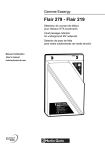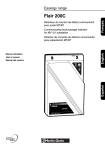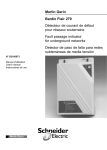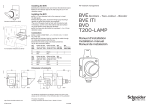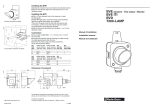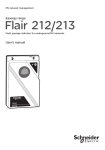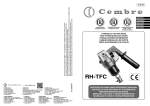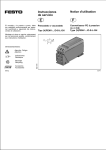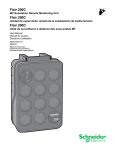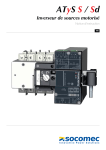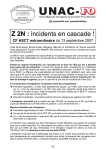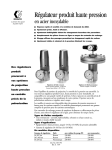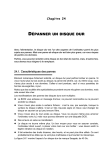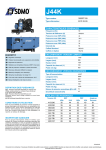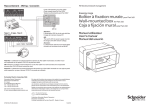Download Flair 279
Transcript
MV network management Flair 279 Détecteur de courant de défaut pour réseaux HTA souterrains Fault passage indicator for underground MV networks Detector de paso de falta para redes subterráneas de media tensión Français Easergy range DEFAUT English Manuel utilisateur User’s manual Manual de usuario RAZ / RESET TEST FAULT BT Español LV Flair 279 Installation Installation du boîtier Installation de la signalisation extérieure Installation des tores Montages tritores Montage monotore Sortie contact sec TS Mise à la terre Alimentation 2 3 3 4 5 5 5 5 5 Exploitation Configuration des micro-interrupteurs Généralités Réglages Test de fonctionnement Test fonctionnel Détection de défaut 6 6 7 7 7 7 7 Maintenance Pièces détachées Remplacement de la pile Autodiagnostics 8 8 8 8 Dimensions 9 Nous vous remercions d’avoir choisi le Flair 279 de Schneider Electric pour la détection de défauts sur réseaux HTA souterrains ou aérosouterrains. Ce manuel a été élaboré avec le souci de répondre à toutes les questions que vous pourriez vous poser sur vos détecteurs lumineux. Lisez-le attentivement. N’hésitez pas à nous contacter en cas de doute. D2160073-FR-EN-ES-05 1 Français Sommaire Flair 279 DE58521FR Installation SW1 BP1 J7 G1 LED défaut LD1 1 2 3 4 5 6 7 8 9 10 J4 opt. LD2 OFF ON LED présence BT Micro-interrupteurs de configuration J8 Fonction TEST F2 Fonction RAZ T C R Connecteurs de pile F1 TORES - CT FLASH S2 S1/3Io S1 S1 Pile BT-LV N PH Relais TS J2 J6 J5 Boîtier voyant extérieur Tores 2 x 1,5 mm2 4 x 1,5 mm2 Arrivée tores Entrée BT Flash 220 V Fig. 5 2 D2160073-FR-EN-ES-05 Installation PE55061 Installation du boîtier Français Ouvrir l’appareil à l’aide des pattes de clipsage situées en haut du boîtier. Pour cela (fig. 6) : b Pousser les pattes vers l’extérieur (A) tout en séparant le socle du capot (B) et, b Fixer le socle à l’aide de vis. Installation de la signalisation extérieure PE55062 DE58523FR Fig. 6 Commun Vert Rouge ou Commun Rouge DE55132 Fig. 7 Fig. 8 DE55133 Patte de fixation Guide lumière Les signalisations du Flair 279 utilisent uniquement des LEDs. d Ne jamais utiliser un voyant à ampoule. b Trois types de signalisations extérieures au choix : v soit un boîtier extérieur standard (fig. 7), fixation murale par 2 vis Ø 4 mm, v soit un voyant à visser pour parois minces y 6 mm (fig. 8), v soit un boîtier antivandalisme (fig. 9). b Pour monter le boîtier antivandalisme : v percer un trou Ø 12 mm dans le mur pour le passage du guide de lumière, v installer le guide de lumière, monter la patte de fixation en la bloquant contre celui-ci, positionner l’ensemble. L’extrémité du guide de lumière doit affleurer le mur extérieur. Si nécessaire, couper la tige côté extérieur et surfacer la coupe à l’abrasif granulométrie 400. v forer le trou de fixation, puis bloquer la patte (cheville + vis). Raccordement Il est possible d’utiliser du câble téléphonique ou du conducteur 2 brins de section 2,5 mm2 pour une longueur max. de 178 m. b Respecter les polarités indiquées sur le boîtier Flair 279 et sur la signalisation. b Vérifier le fonctionnement de la signalisation en simulant un défaut sur le détecteur et ouverture de la BT (cf. tests p. 7). Si le voyant ne clignote pas, soit les polarités n’ont pas été respectées, soit la LED est défectueuse. Dans ce dernier cas, changer le voyant. Mur Fig. 9 D2160073-FR-EN-ES-05 3 Montage “type A” (standard EDF) Ih = 3 Io > 20 A T1 : tore MF1 T2 : tore homopolaire a : tresse de masse d’un câble b : tresse de mise à la terre c : taisceau précâblé d : connecteur détrompé e : cosse jaune Ø 12 mm f : mise à la terre neutre S2 des tores. S2 S1/3Io S1 S1 C 4 x 1,5 mm2 S1 S2 S2 S1 S1 S1 T1 Fig. 10 c d Montage “type B” Ih = 3 Io ≤ 20 A B A J1 DE55134-279 Installation e f S2 S1/3Io S1 S1 A a B C J1 4 x 1,5 mm2 S1 S2 S2 S1 S1 S1 T1 Fig. 11 T2 c d e A Montage monotore a B C S2 S1/3Io S1 S1 J1 2 x 1,5 mm2 S2 S1 Fig. 12 T2 e 4 a D2160073-FR-EN-ES-05 Installation des tores Alimentation Mettre en place le ou les tores sur les câbles MT selon le type de montage choisi (cf. schémas page 6). 220/240 V - 50/60 Hz Nota : le câblage de la basse tension sera effectué conformément aux normes de sécurité locales (NFC 15-100 en France). b Passer le câble 230 V dans le passecâble situé en face du coupe-circuit J5/J6. b Relier le fil de phase à la borne “PH”. b Relier le fil neutre à la borne “N”. L’alimentation 230 V doit être issue de l’aval d’un coupe-circuit HPC (haut pouvoir de coupure) pour les montages EDF. Lorsque la BT est connectée, la LED témoin de présence BT doit être allumée. Dans le cas contraire, vérifier le coupecircuit de la carte. b Connecter la pile. Avant toute utilisation du Flair 279, attendre 15 s après une connexion ou reconnexion de la pile. En absence de BT, une autonomie de 400 h est assurée par la pile. b Montages tritores v Montage “type A” (standard EDF) 3 tores MF1 + faisceau de raccordement pour courant de défaut phase-terre Ih u 20 A. v Montage “type B” 2 tores MF1 + 1 tore homopolaire + faisceau de raccordement pour courant de défaut phase-terre Ih y 20 A. d Important Monter les 3 tores dans le même sens. Passer la tresse de masse d’un câble à l’intérieur du tore. b Montage monotore 1 tore homopolaire. d Important La tresse de mise à la terre doit passer à l’intérieur du tore. Toutes les tresses doivent être isolées. Sortie contact sec TS b Connecter s’il y a lieu la sortie J3 au câble correspondant. Rappel : Travail V point 1 Commun V point 2 Repos V point 3 Son pouvoir de coupure est de : v 5 A/250 V alternatif, v 5 A/ 30 V et 0,5 A/100 V continu. Remarque : lors d’un long stockage, le pack de piles peut être passivé, et de ce fait ne pas pouvoir fournir le courant nécessaire au fonctionnement du Flair. Pour le dépassiver : v court-circuiter ses bornes par une résistance 47 ohms - 3 W, v attendre, 10 à 30 s suivant l’état des piles, une élévation décelable de la température de résistance. Mise à la terre Le circuit imprimé du détecteur Flair 279 ne nécessite pas de mise à la terre. Il satisfait en effet sans mise à la terre aux essais de CEM (Compatibilité ElectroMagnétique). D2160073-FR-EN-ES-05 5 Français Installation Exploitation En gras, réglages standard EDF Configuration des micro-interrupteurs Seuil courant de phase Imax SW1 Imax 225 A 450 A 575 A 700 A 1 OFF ON OFF ON 2 OFF OFF ON ON Seuil courant homopolaire Ih SW1 Ih (3 Io) 5A 10 A 15 A 20 A 25 A 30 A 35 A 40 A 50 A 60 A 70 A 80 A 100 A 120 A 140 A 160 A 3 OFF ON OFF ON OFF ON OFF ON OFF ON OFF ON OFF ON OFF ON 4 OFF OFF ON ON OFF OFF ON ON OFF OFF ON ON OFF OFF ON ON 5 OFF OFF OFF OFF ON ON ON ON OFF OFF OFF OFF ON ON ON ON 6 OFF OFF OFF OFF OFF OFF OFF OFF ON ON ON ON ON ON ON ON Configuration de la RAZ Rappel sur position 7 Si la RAZ est positionnée sur “OFF” inactive, le défaut est mémorisé. Le voyant va clignoter pendant 2 ou 4 h même si le détecteur est réalimenté en BT. A utiliser avec alimentation BT secourue. SW1 Inactif Actif 7 OFF ON Temps max. signalisation SW1 2h 4h 8 OFF ON Temps d’acquisition du défaut SW1 50 ms 100 ms 200 ms 350 ms 6 9 OFF ON OFF ON 10 OFF OFF ON ON D2160073-FR-EN-ES-05 Exploitation Le Flair 279 doit détecter le défaut avant que la protection du départ MT concerné ne déclenche. Pour cela : b Les seuils Ih (courant homopolaire = 3 Io) et Imax (courant entre phases) seront choisis immédiatement inférieurs à ceux de la protection du départ. b Le temps de prise en compte du défaut devra être inférieur au temps total d’ouverture de la protection (relais + disjoncteur). d Si ce temps est trop court, le Flair va signaler tous les défauts, y compris les fugitifs. Si ce temps est trop long, le disjoncteur du départ HTA risque de déclencher avant le signalement du défaut. Voir tableaux page 6 : en gras, réglages standard EDF Réglages Capot ouvert, positionner les microinterrupteurs de configuration SW1 selon les tableaux de la page 6. Test de fonctionnement Après configuration, procéder à un test de fonctionnement sur les 2 possibilités de RAZ. Position “ON” RAZ par retour BT activée (micro-interrupteur 7 de SW1 sur ON) b Ouvrir l’arrivée BT par J5/J6 ou par le coupe-circuit F1. b Effectuer TEST/RAZ (bouton-poussoir). b La signalisation externe et la LED1 (défaut) clignotent, la sortie relais J3 passe en position “travail”. d Si pendant les 3 premières secondes le clignotement de la LED est rapide, la chaîne de détection est défectueuse. b Attendre 10 s, puis refermer l’arrivée BT. b La signalisation s’arrête, J3 passe en position “repos”. b La signalisation s’arrête, J3 passe en position “repos”. Refermer le boîtier en engageant d’abord les pattes inférieures du capot dans le socle et rabattre jusqu’au clipsage. Test fonctionnel Ce test comprend les contrôles de Imax, Ih, temps. Vous pouvez le réaliser si vous disposez d’une valise d’essai VALTEST. Reportez-vous à la notice correspondante. Détection de défaut Le courant de défaut est détecté lorsqu’il a dépassé le seuil 3 Io ou Imax pendant une durée u au temps de prise en compte. La signalisation visuelle se déclenche et le contact J3 du relais TS passe en position “travail” pendant 3 s minimum. La période de clignotement évolue en fonction du temps T passé en signalisation : v 2 s (T < 2 h) v 3 s (T < 3 h) v 4 s (T < 4 h) Le retour à l’état de veille est fonction de la programmation RAZ et de la présence ou absence de MT. Position “ON” RAZ par retour BT ou courant activée : b Avec MT présente : immédiat après le retour BT. b Avec MT absente : v à la fin de la durée programmée, v ou par action volontaire sur TEST/RAZ, v ou au retour stable de la MT. Position “OFF” RAZ par retour BT ou courant inactivée : b A la fin de la durée programmée. b Ou par action volontaire sur TEST/RAZ. Position “OFF” RAZ par retour BT inactivée : b Effectuer TEST/RAZ. b La signalisation externe et la LED1 (défaut) clignotent, la sortie relais J3 passe en position “travail”. b Attendre 10 s, puis effectuer TEST/RAZ. D2160073-FR-EN-ES-05 7 Français Généralités Maintenance Références des pièces détachées b Coupe-circuit F1 (et rechange F2) : In : 160 mA - Un : 250 V - Pdc : 1500 A Dimensions : 5 x 20 mm. b Pile : C2091348 - EDF 49 43 330 - CDI 59 965 Remplacement de la pile b b b b Enlever la pile usagée. Attendre 2 mn avant de placer la nouvelle pile. Mettre en place la nouvelle pile et attendre 15 s. Lancer un test (cf. p. 7) pour vérifier que tout fonctionne. Autodiagnostics b Chaîne de détection Procéder à un test de fonctionnement comme décrit page 7. b Etat de la pile SW1-7 en position activée et BT présente (LD2 allumée). Effectuer TEST/RAZ, si 6 s après le déclenchement du Flair 279, un clignotement rapide apparaît pendant 3 s, la pile est en fin de vie. Dans ce cas, le contact J3 ne passe en position “travail” que 9 s après le déclenchement. Le remplacement de la pile doit être envisagé à court terme. 8 D2160073-FR-EN-ES-05 PE55063 Dimensions Français Boîtier du détecteur Flair Dimensions : 250 x 160 x 65 mm Poids net : 812 g Températures stockage : – 25 °C à + 70 °C Fonctionnement : – 25 °C à + 55 ° C N.B. : l’appareil doit être stocké avec la pile déconnectée. Boîtier voyant à LEDs standard Boîtier voyant antivandalisme Voyant à LED DE55131 5 30 26 20 M22 x 1 12 50 62,5 D2160073-FR-EN-ES-05 9 Installation Box installation Installation of the outdoor display unit Installation of CTs 3 CT wirings 1 CT wiring Dry contact output (SCADA) Earthing Power supply 2 3 3 4 5 5 5 5 5 Operation Micro-switches configuration General information Settings Working test Functional test Fault detection 6 6 7 7 7 7 7 Maintenance Spare parts Battery change Self-diagnostics 8 8 8 8 Dimensions 9 We would like to thank you for choosing the Schneider Electric Flair 279 for fault detection on underground and aerounderground MV networks. This manual was compiled in order to answer any questions you may have regarding your light indicators. Please read it carefully. Do not hesitate to contact us should you have any doubts. D2160073-FR-EN-ES-05 1 English Flair 279 contents DE58521EN Installation SW1 BP1 J7 G1 Fault LED LD1 1 2 3 4 5 6 7 8 9 10 J4 opt. LD2 OFF ON Low voltage presence LED Micro-switches configuration J8 TEST function F2 Reset function T C R Battery connectors F1 TORES - CT FLASH S2 S1/3Io S1 S1 Battery BT-LV N PH SCADA output relay J2 J6 J5 Outdoor indicator lamp box CT’s 2 x 1,5 mm2 4 x 1,5 mm2 CT incoming cable Low voltage input Flash 220 V Fig. 5 2 D2160073-FR-EN-ES-05 Installation PE55061 Box installation Open the unit using the clips at the top of the box. For this (fig. 6): b Push the clips outwards (A) separating the base from the cover (B) and, b Fix the base with the screws. DE55133 Connection A double-strand conductor or telephone cable with a 2.5 mm2 section can be used for a maximum length of 178 m. b Respect the polarities indicated on the Flair 279 box and on the display unit. b Check that the display unit is operating correctly by simulating a fault on the detector and opening the low voltage (see tests, page 7). If the indicator lamp does not flash, either the polarities have not been respected or the LED is faulty. In the latter case, change the lamp. PE55062 DE58523EN DE55132 The Flair 279 signals only use LEDs. d Never use a light bulb assembly. b There is a choice of three types of outdoor display units: v a standard outdoor box (fig. 7), wall mounting with two 4 mm diameter screws, v an indicator lamp to be screwed in for thin walls y 6 mm (fig. 8), v an anti-vandalism box (fig. 9). b mount the anti-vandalism box: v drill a 12 mm Ø hole in the wall for the light guide to pass through, v install the light guide, mount the fixing lug, locking it against the guide, position the unit. The end of the light guide must be level with the outside wall. If necessary, cut the external side of the stud and surface the cut edge with abrasive (size grading 400). v drill the mounting hole and fix the lug (plug + screw). Common Green Red or Common Red Fig. 7 Fig. 8 Fixing bracket Light guide Wall Fig. 9 D2160073-FR-EN-ES-05 3 English Installation of the outdoor display unit Fig. 6 “Type A” wiring Ih = 3 Io > 20 A T1: MF1 CT T2: earth CT a: cable earthing strap b: earthing strap c: pre-wired bundle d: polarised connector e: yellow 12 mm Ø socket f: neutral earthing S2 for CTs. S2 S1/3Io S1 S1 C 4 x 1,5 mm2 S1 S2 S2 S1 S1 S1 T1 Fig. 10 c d “Type B” wiring Ih = 3 Io ≤ 20 A B A J1 DE55134-279 Installation e f S2 S1/3Io S1 S1 A a B C J1 4 x 1,5 mm2 S1 S2 S2 S1 S1 S1 T1 Fig. 11 T2 c d e A 1-CT wiring a B C S2 S1/3Io S1 S1 J1 2 x 1,5 mm2 S2 S1 Fig. 12 T2 e 4 a D2160073-FR-EN-ES-05 Installation of CTs Power supply Install the CT(s) on the medium voltage cables according to the type of wiring chosen (see diagrams on page 6). 220/240 V - 50/60 Hz Note: low voltage wiring is carried out in accordance with local safety standards. b Insert the 230-V cable into the cable bushing located opposite circuit breaker J5/J6. b Connect the phase conductor to connector “PH”. b Connect the neutral wire to connector “N”. The 230-V power must be supplied downstream of a HPC (high breaking capacity) circuit breaker for EDF wiring. When the low voltage is connected, the low voltage presence indicator LED must be lit. If this is not the case, check the board circuit breaker. b Connect the battery. Whenever using the Flair 279, wait 15 s after connecting or reconnecting the battery. If there is no low voltage, the battery ensures autonomous operation for 400 hours. b 3-CT wiring v “Type A” wiring Three MF1 CTs + connection bundle for phase-earth fault current Ih u 20 A. v “Type B” wiring Two MF1 CTs + earth CT + connection bundle for phase-earth fault current Ih y 20 A. d Important Mount the three CTs in the same direction. Put the cable earthing strap inside the CT. b 1-CT wiring One earth CT. d Important The earthing strap must go inside the CT. All straps must be insulated. Dry contact output (SCADA) b If necessary, connect output J3 to the corresponding cable. Note: Work V point 1 Common V point 2 Reset V point 3 It has a breaking capacity of: v 5 A/250 V AC, v 5 A/30 V and 0.5 A/100 V DC. Earthing English Installation Remark: in case of long stocking, the battery pack might get “passivated”, and therefore not be able to provide the current needed by the Flair. In order to “depassivate”: v short-circuit its terminals through a 47 Ohms - 3 W resistor, v wait 10 to 30 s, according to the battery state, for a detectable increase of the resistor temperature. The printed circuit of the Flair 279 indicator does not require an earth connection. It satisfies the CEM (ElectroMagnetic Compatibility) tests without an earth connection. D2160073-FR-EN-ES-05 5 Operation In bold, factory settings Micro-switches configuration Imax phase current threshold SW1 Imax 225 A 450 A 575 A 700 A 1 OFF ON OFF ON 2 OFF OFF ON ON Ih homopolar current threshold SW1 Ih (3 Io) 5A 10 A 15 A 20 A 25 A 30 A 35 A 40 A 50 A 60 A 70 A 80 A 100 A 120 A 140 A 160 A 3 OFF ON OFF ON OFF ON OFF ON OFF ON OFF ON OFF ON OFF ON 4 OFF OFF ON ON OFF OFF ON ON OFF OFF ON ON OFF OFF ON ON 5 OFF OFF OFF OFF ON ON ON ON OFF OFF OFF OFF ON ON ON ON 6 OFF OFF OFF OFF OFF OFF OFF OFF ON ON ON ON ON ON ON ON RESET configuration Position 7 reminder If the RESET is positioned to inactive “OFF”, the fault is stored. The indicator lamp will flash for two or four hours even if the indicator is once again supplied with low voltage. To be used with emergency low voltage power supply. SW1 Inactive Active 7 OFF ON Max. signalling time SW1 2h 4h 8 OFF ON Fault acknowledgement time SW1 50 ms 100 ms 200 ms 350 ms 6 9 OFF ON OFF ON 10 OFF OFF ON ON D2160073-FR-EN-ES-05 Operation The Flair 279 must detect the fault before the relevant medium voltage output protection can be triggered. For this: b The Ih (homopolar current = 3 lo) and Imax (current between phases) thresholds are chosen to be immediately below the output protection thresholds. b The fault processing time should be shorter than the total on-period of the protection (relay + circuit breaker). d If the set time is too short, the Flair will trigger for all faults, including transient faults. If the set time is too long, the Flair will not signal the fault. Settings With the cover open, position the SW1 configuration micro-switches according to the tables on page 6. Working test After configuration, perform an operational test on the two possibilities of RESET. “ON” position RESET by activated low voltage return: b Open the low voltage incoming cable with J5/J6 or the F1 circuit breaker. b Perform TEST/RESET. b The outdoor display unit and LED1 (fault) flash, relay output J3 moves into “work” position. d If the LED flashes quickly for the first three seconds, the detection chain is faulty. of the cover onto the base and pushing it down until it snaps on. Functional test This test includes Imax, Ih and time checks. This test can be performed with a VALTEST portable testing unit. Please refer to the relevant manual. Fault detection The fault current is detected when it exceeds the 3 Io or Imax threshold for a duration u the processing time. The visual signal is triggered and contact J3 of SCADA output moves into “work” position for 3 s minimum. The flashing period changes according to the signalling time T: v 2 s (T < 2 h) v 3 s (T < 3 h) v 4 s (T < 4 h) The return to standby state depends on the RESET programming and on the presence or absence of MV. English General information “ON” position RESET by activated LV or current return: b With MV: immediately after the LV return. b Without MV: v at the end of the duration programmed, v by activating TEST/RESET voluntarily, v or at the stable return of the MV. “OFF” position RESET by inactivated LV or current return: b At the end of the duration programmed. b Or by activating TEST/RESET voluntarily. b Wait 10 seconds, then close the low voltage incoming cable. b The signalling stops, J3 moves into “rest” position. “OFF” position RESET by inactivated low voltage return: b Perform TEST/RESET. b The outside display unit and LED1 (fault) flash, relay output J3 moves into “work” position. b Wait 10 s, then perform TEST/RESET. b The signalling stops, J3 moves into “rest” position. Shut the box by latching the lower lugs D2160073-FR-EN-ES-05 7 Maintenance Spare part references b Fuse F1 (and replacement F2): In: 160 mA - Un: 250 V - Pdc: 1500 A Dimensions: 5 x 20 mm. b Battery: C2091348 - EDF 49 43 330 - CDI 59 965 Battery replacement b b b b Remove the used battery. Wait two minutes before inserting the new battery. Insert the new battery and wait 15 s. Start the test (see p. 7) to check that it is operating correctly. Self-diagnostics b Detection chain Perform an operational test as described on page 7 according. b Battery status SW1-7 in activated position and low voltage present (LD2 lit). Perform TEST/RESET, if six seconds after the Flair 279 is triggered, there is rapid flashing for three seconds, the battery is at the end of its life. In this case, contact J3 only moves into “work” position nine seconds after the triggering. Battery replacement must be planned in the short term. 8 D2160073-FR-EN-ES-05 PE55063 Dimensions English Flair detector box Dimensions: 250 x 160 x 65 mm Net weight: 812 g Temperatures storage: – 13°F to + 158°F Operation: – 13°F to + 131°F N.B.: the unit must be stored with the battery disconnected. Standard LED indicator lamp box Anti-vandalism indicator lamp box LED indicator lamp DE55131 5 30 26 20 M22 x 1 12 50 62,5 D2160073-FR-EN-ES-05 9 Instalación Instalación de la caja Instalación de la caja externa de señalización Instalación de los sensores Montajes con 3 sensores Montaje con 1 sensor Salida contacto seco TS Conexión a tierra Alimentación 2 3 3 4 5 5 5 5 5 Explotación Micro-interruptores de configuración Generalidades Ajustes Test de funcionamiento Test funcional Detección de fallas 6 6 7 7 7 7 7 Mantenimiento Piezas de recambio Sustitución de la pila Auto-diagnósticos 8 8 8 8 Dimensiones 9 Le agradecemos que haya elegido Flair 279 de Schneider Electric para la detección de defectos en redes de media tensión subterráneas o aéro-subterráneas. Este manual se ha elaborado con objeto de contestar a todas las preguntas que pueda plantearse sobre sus indicadores luminosos. Léalo atentamente. No dude en ponerse en contacto con nosotros en caso de dudas. D2160073-FR-EN-ES-05 1 Español Tabla Flair 279 DE58521ES Instalación SW1 BP1 J7 G1 LED indicador de fallas LD1 1 2 3 4 5 6 7 8 9 10 J4 opt. LD2 OFF ON LED testigo de presencia de BT Micro-interruptores de configuración J8 Función TESTO F2 Función PAC T C R Conectores de pila F1 TORES - CT FLASH S2 S1/3Io S1 S1 Pila BT-LV N PH Relés TS J2 J6 J5 Caja de señalización externa Toroides 2 x 1,5 mm2 4 x 1,5 mm2 Llegada de los sensores de corriente Entrada BT Flash 220 V Fig. 5 2 D2160073-FR-EN-ES-05 Instalación PE55061 Instalación de la caja Abra el aparato con las patillas de grapado situadas en la parte superior de la caja. Para ello (fig. 6): b Empuje las patillas hacia el exterior (A) separando al mismo tiempo la base de la cubierta (B) y, b Fije la base con tornillos. Instalación de la caja externa de señalización Común Verde Rojo o Rojo Común DE55132 Fig. 7 Fig. 8 DE55133 Clavo sujetador Guía de luz Las señalizaciones de Flair 279 utilizan únicamente indicadores electroluminiscentes (LEDs). d No utilice nunca un indicador de bombilla. b Tres tipos de señalización externa a elegir: v una caja externa estándar (fig. 7), fijación mural con 2 tornillos Ø 4 mm, v o un indicador de rosca para paredes delgadas y 6 mm (fig. 8), v o una caja anti-vandalismo (fig. 9). b Para montar la caja anti-vandalismo: v perfore un orificio de un Ø de 12 mm en la pared para el paso de la guía-luz, v instale la guía-luz, monte la patilla de fijación bloqueándola contre la guía-luz, coloque el conjunto. El extremo de la guía-luz debe estar al mismo nivel que la pared externa. Si es necesario, corte la varilla por el lado exterior y alise el corte con abrasivo de granulometría 400. v perfore el orificio de fijación y bloquee la patilla (clavija + tornillo). Conexión Se puede utilizar cable telefónico o de conductor con 2 ramales con una sección 2,5 mm2 para una longitud máx. de 178 m. b Respete las polaridades indicadas en la caja Flair 279 y en la señalización. b Compruebe el funcionamiento de la señalización simulando una falla en el indicador mediante y abertura de la BT (cf. tests página 7). Si el piloto luminoso no parpadea, bien las polaridades no se han respetado, o bien el LED es defectuoso. En este último caso, cambie el piloto luminoso. Pared Fig. 9 D2160073-FR-EN-ES-05 3 Español PE55062 DE58523ES Fig. 6 Montaje de “tipo A” Ih = 3 Io > 20 A T1: sensor de corriente MF1 T2: sensor de tierra a: trenzado de masa de un cable b: trenzado de conexión a tierra c: haz precableado d: conector con ranura indexada e: terminal amarillo Ø 12 mm f: conexión a tierra neutra S2 de los sensores de corriente. S2 S1/3Io S1 S1 C 4 x 1,5 mm2 S1 S2 S2 S1 S1 S1 T1 Fig. 10 c d Montaje de “tipo B” Ih = 3 Io ≤ 20 A B A J1 DE55134-279 Instalación e f S2 S1/3Io S1 S1 A a B C J1 4 x 1,5 mm2 S1 S2 S2 S1 S1 S1 T1 Fig. 11 T2 c d e A Montaje con un sensor a B C S2 S1/3Io S1 S1 J1 2 x 1,5 mm2 S2 S1 Fig. 12 T2 e 4 a D2160073-FR-EN-ES-05 Instalación Instalación de los sensores Alimentación Coloque el o los sensores de corriente en los cables MT según el tipo de montaje escogido (cf. esquemas de las página 6). 220/240 V - 50/60 Hz Nota: el cableado de baja tensión se efectuará de acuerdo con las normas de seguridad locales. b Pase el cable 230 V por el pasacables situado enfrente del cortacircuito J5/J6. b Conecte el hilo de fase al borne “PH”. b Conecte el hilo neutro al borne “N”. La alimentación 230 V debe estar situada después de un fusible HPC (alta potencia de corte) para los montajes EDF. Cuando la BT está conectada, el LED testigo de presencia de BT debe estar encendido. Si no es así, compruebe el fusible de la tarjeta. b Conecte la pila. Cada vez que utilice Flair 279, espere 15 s tras una conexión o reconexión de la pila. Cuando no hay BT, la pila garantiza una autonomía de 400 h. b Montaje con un sensor 1 sensor de corriente a tierra. d Importante El trenzado de conexión a tierra debe pasar por dentro del sensor laminado. Todos los trenzados deben estar aislados. Salida contacto seco TS b Conecte, si es necesario, la salida J3 al cable correspondiente. Nota: Trabajo V punto 1 Común V punto 2 Reposo V punto 3 Su poder de corte es de: v 5 A/250 V alterna, v 5 A/ 30 V y 0,5 A/100 V continua. Nota: después de quedar sin funcionar la batería puede ser “pasivada”, en este caso no dara el corriente suficiente para el funcionamiento del Flair. Para poner in orden de marcha la batería: v hacer un corte-circuito entra sus bornes con una resistencia de 47 Ohms - 3 W, v esperar 10 o 30 s según el estado de la batería una elevación sensible de la temperatura de la resistencia. Español b Montajes con tres sensores v Montaje de “tipo A” 3 sensores de corriente MF1 + haz de conexión para corriente de defecto fase-tierra Ih u 20 A. v Montaje de “tipo B” 2 sensores de corriente MF1 + 1 sensor de corriente a tierra + haz de conexión para corriente de defecto fase-tierra Ih y 20 A. d Importante Monte los 3 sensores de corriente en el mismo sentido. Pase el trenzado de masa de un cable por dentro del sensor. Conexión a tierra El circuito impreso del indicador Flair 279 no requiere conexión a tierra. Supera, sin conexión a tierra, las pruebas de CEM (Compatibilidad ElectroMagnética). D2160073-FR-EN-ES-05 5 Explotación In bold, factory settings Micro-interruptores de configuración Umbral corriente de fase Imax SW1 Imax 225 A 450 A 575 A 700 A 1 OFF ON OFF ON 2 OFF OFF ON ON Umbral corriente homopolar Ih SW1 Ih (3 Io) 5A 10 A 15 A 20 A 25 A 30 A 35 A 40 A 50 A 60 A 70 A 80 A 100 A 120 A 140 A 160 A 3 OFF ON OFF ON OFF ON OFF ON OFF ON OFF ON OFF ON OFF ON 4 OFF OFF ON ON OFF OFF ON ON OFF OFF ON ON OFF OFF ON ON 5 OFF OFF OFF OFF ON ON ON ON OFF OFF OFF OFF ON ON ON ON 6 OFF OFF OFF OFF OFF OFF OFF OFF ON ON ON ON ON ON ON ON Configuración de la PAC Nota sobre la posición 7 Si la PAC se coloca en “OFF” inactivo, el defecto se memoriza. El piloto luminoso parpadea durante 2 o 4 h, incluso si el indicador vuelve a alimentarse con BT. Se utiliza con alimentación de BT ininterrumpida. SW1 Inactivo Activo 7 OFF ON Tiempo máx. señalización SW1 2h 4h 8 OFF ON Tiempo de adquisición del defecto SW1 50 ms 100 ms 200 ms 350 ms 6 9 OFF ON OFF ON 10 OFF OFF ON ON D2160073-FR-EN-ES-05 Explotación Flair 279 debe detectar el defecto antes de que la protección inicial MT correspondiente se active. Para ello: b Se seleccionarán los umbrales Ih (corriente homopolar = 3 Io) y Imax (corriente entre fases) inmediatamente inferiores a los de la protección inicial. b El tiempo de integración del defecto debe ser inferior al tiempo total de apertura de la protección (relé + disyuntor). d Si el tiempo es muy bajo, el Flair va a detectar todos los defectos, incluyendo los defectos transitorios. Si el tiempo es muy largo, el Flair no va a parpadear. Ajustes Con la cubierta abierta, coloque los microinterruptores de configuración SW1 de acuerdo con los cuadros de la página 6. Test de funcionamiento Tras la configuración, realice una prueba de funcionamiento en las 2 posibilidades de la PAC. Posición “ON” PAC mediante retorno de BT activada: b Abra la llegada BT por J5/J6 o mediante el fusible F1. b Efectúe TEST/PAC. b La señalización externa y el LED1 (falla) parpadean, la salida relé J3 vuelve a la posición “trabajo”. d Si durante los 3 primeros segundos el parpadeo del LED es rápido, la cadena de detección está averiada. b Espere 10 s y cierre la llegada de BT. b La señalización se para, J3 vuelve a la posición “reposo”. Posición “OFF” PAC mediante vuelta BT desactivada: b Efectúe TEST/PAC. b La señalización externa y el LED1 (falla) parpadean, la salida relé J3 vuelve a la posición “trabajo”. b Espere 10 s y cierre la llegada de BT. b La señalización se para, J3 vuelve a la posición “reposo”. D2160073-FR-EN-ES-05 Cierre la caja acoplando primero las patillas inferiores de la cubierta en la base y repliegue hasta que se grape. Test funcional Este test incluye los controles de Imax, Ih y tiempo. Puede realizarlo si dispone de una maleta de prueba VALTEST. Remítase al manual correspondiente. Detección de fallas La corriente de defecto se detecta cuando supera el umbral 3 Io o Imax durante un periodo de tiempo u al tiempo de integración. La señalización visual se activa y el contacto J3 del relé TS pasa a la posición “trabajo” durante 3 s como mínimo. El periodo de parpadeo varia en función del tiempo T pasado en señalización: v 2 s (T < 2 h) v 3 s (T < 3 h) v 4 s (T < 4 h) La vuelta al estado de espera depende de la programación PAC y de la presencia o ausencia de MT. Posición “ON” PAC mediante retorno de BT o del corriente activada: b Con MT presente: inmediato tras la vuelta BT. b Con MT ausente: v al final del periodo de tiempo programado, v o mediante acción voluntaria en TEST/PAC, v o a la vuelta estable de la MT. Español Generalidades Posición “OFF” PAC mediante vuelta BT o del corriente desactivada: b Al final del periodo de tiempo programado. b O mediante acción voluntaria en TEST/PAC. 7 Mantenimiento Referencias de las piezas de recambio b Fusible F1 (y recambio F2): In: 160 mA - Un: 250 V - Pdc: 1500 A Dimensiones: 5 x 20 mm. b Pila: C2091348 - EDF 49 43 330 - CDI 59 965 Sustitución de la pila b Retire la pila gastada. b Espere 2 min antes de colocar la pila nueva. b Coloque la pila nueva y espere 15 s. b Inicie un test (cf. página 7) para comprobar que todo funciona bien. Auto-diagnósticos b Cadena de detección Realice una prueba de funcionamiento como se describe en la página 7. b Estado de la pila SW1-7 en posición activada y BT presente (LD2 encendido). Efectúe TEST/PAC, si 6 s después de la activación de Flair 279 aparece un parpadeo rápido durante 3 s, la pila está gastada. En este caso, el contacto J3 sólo se coloca en posición “trabajo” 9 s después de la activación.La pila debe sustituirse a corto plazo. 8 D2160073-FR-EN-ES-05 PE55063 Dimensiones Caja del indicador de fallas Flair Dimensiones: 250 x 160 x 65 mm Peso neto: 812 g Temperaturas almacenamiento: – 25 °C a + 70 °C Funcionamiento: – 25 °C a + 55 ° C N.B.: el aparato debe almacenarse con la pila desconectada. Español Caja de señales con LEDs estándar Caja de indicadores anti-vandalismo Señales con LED DE55131 5 30 26 20 M22 x 1 12 50 62,5 D2160073-FR-EN-ES-05 9 Schneider Electric Industries SAS Schneider Electric Telecontrol 839 Chemin des Batterses Z.I. Ouest 01700 St Maurice de Beynost Tel.: +33 (0)4 78 55 13 13 Fax: +33 (0)4 78 55 50 00 http://www.schneider-electric.com E-mail: [email protected] En raison de l’évolution des normes et du matériel, les caractéristiques indiquées par les textes et les images de ce document ne nous engagent qu’après confirmation par nos services. As standards, specifications and designs change from time to time, please ask for confirmation of the information given in this publication. Debido a la evolución de las normas y del material, las características y dimensiones indicadasen el texto y las imágenes nos comprometen solamente previa confirmación de nuestros servicios. This document has been printed on ecological paper Publication: Schneider Electric Telecontrol Production: Graphème Printing: Schneider Electric Telecontrol - Made in France D2160073-FR-EN-ES-05 07-2008
































